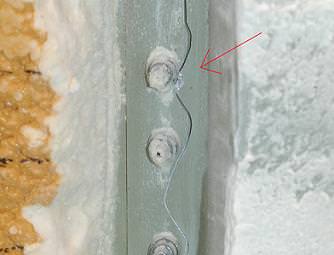The chances of space shuttle Discovery launching on the STS-133 mission in 2010 could be in jeopardy. Cracked foam on the shuttle’s external tank was removed early Wednesday morning and underneath engineers found a structural crack on the tank itself. The serpentine crack is about 22 cm (9 inches) long and is located on a structural rib or “stringer.” Cracks like this have appeared on other tanks and were fixed at the production facility in New Orleans. But this type of repair has never been attempted at the launch pad.
Engineers are also working to pin down the cause of a hydrogen gas leak, which forced NASA to call off the launch last week. The next launch window opens November 30 and closes December 6. But with the hydrogen leak work still ongoing, and given the uncertainties of the crack, it seems unlikely Discovery could be ready to go within that time frame.
The website NASASpacefight.com said similar repairs have been done by “removing the cracked aluminum and replacing it with a “doubler,” which is a twice-as-thick stringer section before replacing the foam insulation.” But again, this has only been done at the production facility.
Former shuttle launch director Wayne Hale posted a comment on NASA Spaceflight.com, saying the crack was troubling. “Not only does this most likely have to be repaired – and that could be difficult,” Hale wrote, “ but understanding the root cause of the problem and developing flight rationale are going to be very difficult. I am thinking that a launch this calendar year is in jeopardy. Good luck to the team, if anybody can solve it the folks at MAF, MSFC, and the other centers can do it. I hope I am being overly pessimistic and this turns out to be simple; but right now it doesn’t look like it.”
Discovery’s mission to the International Space Station will bring a new storage module and the first humanoid robot, Robonaut 2, or R2 to the station
Source: NASASpaceflight.com


Double Dzzzz…..
I was down there for the launch, but had no cushion even for a 24-hour hold. This looks serious enough to push it to next year. Very frustrating for the crew, I’m sure. R2 will take it in stride. Maybe there will be a window of opportunity for me for these later launches, but my sister may have sold her house by then (she lives on Merritt Island).
It amazes me to learn that structural cracks of that type have occured more than once, that the producer has a special stronger spare part to fix it. This is weird way of solving the problem. The only acceptable concept of mending a crack in the structure is a design concept that rules out that any cracks can occur.
Good job finding the crack!
Flight qualified material costs mints, do to its quality control. But still it is not 100% assurance. Material defects do slip through still. And yes people are flying around with airliner with some structure with cracks!
Reply to GBENDT:
If you have a static structure, then you can probably make it twice as thick and make a crack increasingly unlikely. However, with something like a Space Shuttle, the structure will then be a lot heavier, so you have to make the tanks bigger to get it off the ground, and so it goes on.
Ideally you would make the material without the initial flaw that causes the crack to start. However, the bit that we see has a join with rivets. If you could spin a tube of perfect material without any seams for the tank, then they would. However, the flaw that causes a crack to start a point A rather than point B may be undetectably tiny. Plus the problem may lie not just in the flaw but in the features of the other structure that may concentrate stress at a particular point.
So, what does the aerospace industry do? They design the structure so it should tolerate cracks growing from the original, undetectable flaw into some macroscopic crack that they can find using ultrasonics, dye penetration, or other such tricks while the crack is still growing slowly and at a predictable rate. They then regularly inspect the whole structure to look for cracks, so they can catch them long before the crack growth suddenly accelerates and the structure tears in half. If they find a crack, they can patch it with a heavier repair, but it is only that little bit that has been repaired, and the rest of the structure is still light.
It may sound silly, but that there was a crack and the crack was found, and that is a sign that everything is working as it should. If there were no cracks then the shuttle would have been over-designed and be heavier then necesary.
Yikes! Retirement can’t seem to come soon enough for these weary old vehicles..
I wonder how many other flights had similar cracks that went unnoticed? The piece of foam that doomed Columbia came from one of the upper tank support strut’s insulation.. right? Is that location a stringer attachment point?
Jesus. It just gets worse. As I said on two of the previous articles about this launch – scrap it and scrap it now. In years to come it will be seen for what it is, a pile of expensive, unreliable junk and have been a waste of time and taken money from better ideas. [again as previously stated Hubble etc notwithstanding]